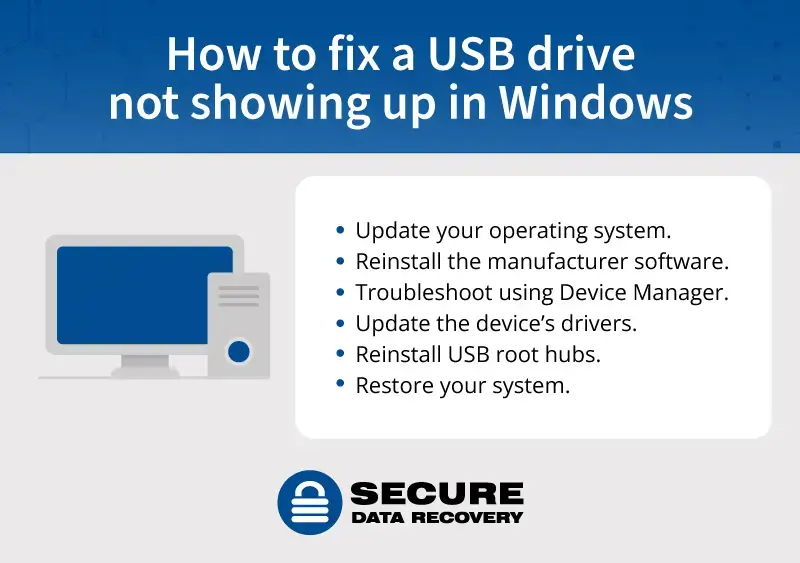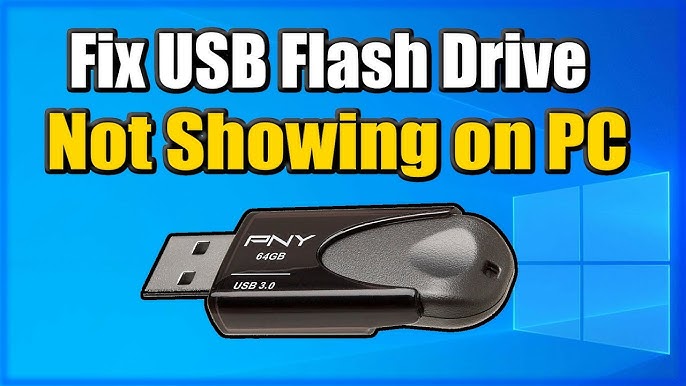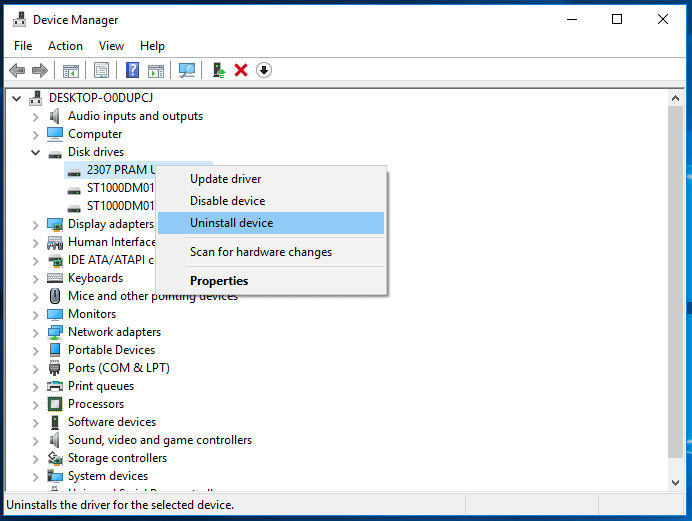Is your USB flash drive not showing in My Computer? This can be frustrating.
But don’t worry, you can fix it. A USB flash drive is a handy tool for storing and transferring data. But sometimes, when you plug it into your computer, it doesn’t appear. This issue can have many causes, such as driver problems, file system errors, or partition issues.
Understanding the reasons can help you find the right solution. In this blog post, we will walk you through simple steps to get your USB flash drive working again. By the end, you should be able to access your files without any hassle. Let’s dive in and solve this problem together.

Credit: www.securedatarecovery.com
Check Usb Port And Drive
Check the USB port and drive connection. A loose or faulty connection can cause the flash drive to not appear. Securely reconnect the drive to a different USB port.
When your USB flash drive isn’t showing up in My Computer, it’s often due to simple issues that can be quickly fixed. One of the first steps you should take is to check the USB port and the drive itself. This step is crucial because it helps you identify whether the problem lies with the hardware or something else.Test Different Ports
Sometimes, the USB port might be the culprit. Try connecting your USB flash drive to different ports on your computer. If it works on another port, the original port might be damaged or malfunctioning. I once had a similar issue, and switching to a different port solved it immediately. If you have access to another computer, test the drive there as well. This will help you determine if the problem is with the USB drive or your computer’s ports.Inspect Usb Drive
Look closely at your USB flash drive. Check for any visible damage like bent pins or a cracked casing. These physical issues can prevent the drive from being recognized by your computer. You might also want to try cleaning the USB connector. Dust and debris can interfere with the connection. A quick wipe with a soft, dry cloth can sometimes make a big difference. Have you ever found a USB drive in the bottom of your bag, only to realize it’s covered in crumbs and dust? That’s a good reminder to keep your USB drives clean and safe. What if your USB drive still doesn’t show up after all these steps? It could be a software issue, but starting with these simple hardware checks can save you a lot of time and frustration. Have you checked your USB ports and drive recently?Verify Drive In Disk Management
If your USB flash drive is not showing up in My Computer, verifying the drive in Disk Management can help. Disk Management is a tool in Windows that lets you see all connected drives. This includes drives that are not visible in My Computer. Follow these steps to check if your USB flash drive appears in Disk Management.
Open Disk Management
To open Disk Management, press the Windows key and the R key at the same time. This will open the Run dialog box. Type “diskmgmt.msc” and press Enter. The Disk Management window will open.
Check Drive Status
In the Disk Management window, look for your USB flash drive in the list of drives. It may not have a drive letter or be labeled as unallocated space. Right-click on the drive to see options. You can assign a drive letter or create a new partition if needed.
Update Usb Drivers
Updating USB drivers can solve the problem of your USB flash drive not showing in My Computer. Drivers act as a bridge between your computer and the hardware. Outdated or corrupted drivers can lead to recognition issues.
Open Device Manager
To update your USB drivers, first open Device Manager. Click on the Start menu and type “Device Manager” in the search bar. Select the Device Manager option from the list.
Locate And Update Drivers
In Device Manager, find “Universal Serial Bus Controllers” and expand the category. Right-click on each USB driver and select “Update Driver.” Follow the prompts to search for updated driver software.
Assign Drive Letter
Assigning a drive letter can fix a USB flash drive not showing in My Computer. Open Disk Management, right-click the USB drive, and select “Change Drive Letter and Paths. “
When your USB flash drive isn’t showing in My Computer, it can be frustrating. One common fix is to assign a drive letter. This simple step can make your USB drive accessible again.Access Disk Management
To start, you need to access Disk Management. Press Win + X and select Disk Management from the menu. You will see a list of all connected drives. Look for your USB flash drive in the list. It might be labeled as Removable or Unknown. If it shows up without a drive letter, you’re on the right track.Assign New Drive Letter
Next, right-click on your USB flash drive in Disk Management. Select Change Drive Letter and Paths from the context menu. A new window will open. Click on Add if no letter is assigned, or Change if you want to assign a different letter. Choose a letter from the dropdown menu that isn’t already in use. Click OK to confirm. Your USB drive should now appear in My Computer. Have you ever had a stubborn USB drive that just wouldn’t show up? Trying this method often resolves the issue quickly. Remember, assigning a drive letter doesn’t delete any data. It simply helps your computer recognize the drive. Have you tried assigning a drive letter to your USB flash drive? What other methods have worked for you? Share your experiences in the comments.Format The Usb Drive
Having trouble with your USB flash drive not showing up in My Computer? Sometimes, formatting the USB drive can solve this issue. Formatting erases all data and sets up the file system again, making the drive accessible. Before you begin, ensure you back up any important data.
Backup Data
Before formatting, always back up your data. Connect the USB drive to another computer. Copy all important files to a safe location. This step ensures no loss of valuable data.
Format Via Disk Management
To format the USB drive, use Disk Management. Press Windows + X and select Disk Management. Locate your USB drive in the list. Right-click on the drive and choose Format. Follow the prompts to complete the process. Choose the file system, either NTFS or FAT32, based on your needs.
After formatting, the USB drive should appear in My Computer. If the issue persists, try using a different USB port or cable. Sometimes, the problem lies with the hardware, not the drive itself.

Credit: www.youtube.com
Check For Hardware Issues
Sometimes, the issue of a USB flash drive not showing in My Computer may be due to hardware problems. Before diving into software fixes, it’s essential to rule out any hardware issues. This will save time and help you pinpoint the exact cause of the problem.
Test On Another Computer
First, connect the USB flash drive to another computer. This helps determine if the issue is with your computer or the flash drive itself. If the drive shows up on the other computer, your computer might have a problem. If it doesn’t show up, the flash drive could be faulty.
Check For Physical Damage
Inspect the USB flash drive for any visible damage. Look at the USB connector and the casing. Dirt or bent connectors can prevent the drive from being recognized. Clean the connectors carefully with a soft cloth. Do not use water or cleaning fluids.
Also, check the USB ports on your computer. Make sure they are clean and not damaged. Sometimes, the issue lies with a faulty USB port rather than the flash drive.
Change Usb Selective Suspend Settings
If your USB flash drive is not showing up in My Computer, changing the USB selective suspend settings can help. This setting can save power but sometimes causes connection issues. By adjusting this, you can ensure your USB drive works properly. Follow these simple steps to make the necessary changes.
Open Power Options
First, you need to access the power options. Click on the Start menu and type “Control Panel”. Open the Control Panel and select “Power Options”. This will show you the different power plans available on your computer.
Disable Usb Selective Suspend
Next, find your current power plan and click on “Change plan settings”. Then, click on “Change advanced power settings”. A new window will open with various settings. Scroll down to find “USB settings”.
Click on the plus sign next to “USB settings” to expand it. You will see “USB selective suspend setting”. Click on the plus sign again. Change the setting to “Disabled” for both “On battery” and “Plugged in”.
Click “Apply” and then “OK” to save your changes. Restart your computer to ensure the new settings take effect. Your USB flash drive should now appear in My Computer.
Use Command Prompt
Struggling with a USB flash drive that is not showing up in My Computer? Using the Command Prompt can be a straightforward solution. This method involves running a series of commands that can help detect and fix issues with your USB drive. Let’s go through the steps to use Command Prompt effectively.
Open Command Prompt
To begin, you need to open the Command Prompt. Press the Windows key and type “cmd” in the search bar. Right-click on “Command Prompt” and select “Run as administrator.” This ensures you have the necessary permissions to execute the required commands.
Run Diskpart Commands
Once the Command Prompt is open, type “diskpart” and press Enter. This command will launch the Diskpart utility. Next, type “list disk” and press Enter. This will display all the disks connected to your computer, including your USB flash drive.
Identify your USB drive from the list. It will usually be labeled as “Disk 1” or a similar number. Type “select disk X” (replace X with the number of your USB drive) and press Enter. The system will confirm that the specified disk is now selected.
Now, type “clean” and press Enter. This command will remove any partitions or data on the selected USB drive. After cleaning the disk, type “create partition primary” and press Enter. This will create a new primary partition on the USB drive.
Finally, type “format fs=ntfs quick” and press Enter. This command will format the USB drive with the NTFS file system quickly. Once the format is complete, type “assign” and press Enter. This will assign a drive letter to your USB flash drive, making it visible in My Computer.
Close the Command Prompt window. Your USB flash drive should now appear in My Computer, ready for use.

Credit: www.easeus.com
Frequently Asked Questions
Why Is My Usb Port Not Showing In My Computer?
Your USB port might not show due to driver issues, faulty hardware, or disabled USB ports in the BIOS settings.
Why Is My Usb Flash Drive Not Showing Up In My Computer?
Your USB flash drive might not show up due to a faulty port, driver issues, or drive corruption. Try another port, update drivers, or check Disk Management.
How To Fix Usb Hard Drive Not Detected?
Check connections, try another USB port. Update drivers. Use Disk Management to assign a drive letter. Check for hardware issues.
How Do I Get My Computer To Read A Flash Drive?
Insert the flash drive into a USB port on your computer. Open “This PC” or “My Computer. ” Locate and click the flash drive icon to access its files. Ensure drivers are updated if the device isn’t recognized.
Conclusion
Fixing a USB flash drive issue can be simple. Follow the steps provided. Check connections, drivers, and settings. Often, these steps solve the problem. If needed, seek professional help. Keeping your USB drive functional is important. Regular maintenance ensures data safety.
Next time, you’ll handle it with ease. Happy computing!
